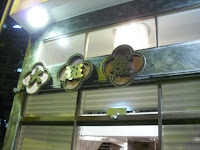Whilst dim sum makes for a great breakfast or lunch, few people have the time, money, or metabolism to indulge a daily dumpling habit. So what are the alternatives? Well, for many Hong Kongers, they like to pop into
cha chaan tengs (茶餐廳). These are best described as the Hong Kong equivalent of the American diner.
These diners are open from breakfast to late into the night, and serve a bewildering array of dishes encompassing Cantonese favourites, HK-style western food, and increasingly so, local versions of South East Asian dishes. For example, breakfast might be
HK-style French toast or
macaroni in broth w/fried egg, and lunch or dinner might consist of
Hainan chicken rice or
Malaysian curry.
One of Hong Kong's most famous
cha chaan tengs is
Tsui Wah (翠華餐廳), a small chain whose flagship branch is on Wellington Street and consists of three cavernous floors. This isn't the place for a quiet chat, and more often than not, you're expected to share a table with other diners.
I pitched up at Tsui Wah with some colleagues, and was confronted with multiple menus. I kept it simple and ordered
fish combination w/rice vermicelli in fish soup (鮮味魚四寶米線), with the 'combination' consisting of squid balls (墨魚丸), fish balls (魚蛋), fish roll (魚春卷), and fish paste puff (魚腐). The quality may not have been the best, but as a workday lunch, it certainly beats the living daylights out of a tired old sarnie. And for a mere
HK$30 (apx £2.50), it's certainly great value.
With hindsight, though, I should've gone for the
Kagoshima pork cartilage in special sauce & fish balls w/rice noodles in fish soup that my colleague ordered. She kindly let me have some of the cartilage (豬軟骨) and it was fantastic, with all the porky goodness demanding to be sucked clean off the soft bone.
However, it was the
flowering chives (韮菜) served with an abalone sauce that stole the show. This dish wouldn't have felt out of place in one of Hong Kong's swankier restaurants, never mind a humble
cha chaan teng.
At the end of the day, Tsui Wah can be uncomfortable and noisy, and you can probably get better quality food at specialist 'hole-in-the-walls' like
Lau Sum Kee. But for all that, a visit to a
cha chaan teng is a must-do, as it is a unique Hong Kong experience.
Tsui Wah 翠華餐廳
G-2/F, 15-19 Wellington Street, Central, Hong Kong
香港 中環 中環威靈頓街15-19號地下至2樓
Nearest MTR: Central 中環
Despite being called Mr Noodles, my favourite Chinese breakfast is
congee, or as it's called in Cantonese:
juk (粥). As this rice porridge is a slow-cooked affair, locals go to a congee shop or
juk diem (粥店) for convenience.
Ocean Empire (海皇粥店) is a mini-chain that serves many different types of congee, all priced around the
HK$20 mark. I went for my favourite of
fish slice congee w/coriander (芫茜魚片粥). For those of you that make congee at home, coriander is a great addition as it introduces an extra herby flavour whilst adding colour too. As I've come to expect from Ocean Empire, this was a fine bowl of congee with delicate flakes of fish and a deep ginger flavour.
Congee is usually topped with a couple of bits of
deep-fried dough stick (
you tiao 油條). However, some people like to order extra
you tiao, and I'm no exception although I like to have it wrapped in
rice noodle roll (
cheung fun 腸粉) to make
zhaliang (炸兩). Ocean Empire rather exuberantly names this dish in English as
twisted doughnut ricesheet roll.
Ocean Empire's version is a good one. As you can see, the freshly made
cheung fun is almost translucent. The fried doughstick is also crispy on the outside and isn't too oily. Incidentally, if you sit near the open kitchen, you can see the
cheung fun being freshly made to order. They do quite a big range of
cheung fun, and I can also recommend the
dried shrimp ricesheet roll (蝦米腸粉). Other dishes include snacks and stir-fried noodles that are mainly served as accompaniments to the signature congee.
Some of Hong Kong's hole-in-the-walls can be inaccessible to non-Chinese readers, and it's to Ocean Empire's credit that their menu is in Chinese (both traditional and simplified characters), English and Japanese. In other words, there's no excuse not to come here!
Rather bizarrely, despite having multilingual menus, a few of their outlets only have Chinese signage. Ocean Empire's logo is as above, if you want to identify this superior
juk diem.
Ocean Empire Food Shop 海皇粥店
Shop 1-2, G/F, 15-23 Sugar Street, Causeway Bay, Hong Kong
香港 銅鑼灣 糖街15-23號地下1-2號舖
Nearest MTR: Causeway Bay 銅鑼灣





















































